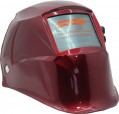Min. degree of darkening
The smallest degree of obscuration provided by the chameleon mask (see "Type") when the light filter is activated. Recall that dimming is indicated in DIN units, the larger the number in this paragraph, the darker the filter.
This parameter is indicated only for models with dimming control (see "Functions"). From the minimum degree of dimming depends on the extent to which you can adjust the light transmission. At the same time, we recall that a darker light filter protects better from bright light, but worsens visibility; so for some tasks, a relatively low level of obscuration may be optimal. Accordingly, the lower this indicator, the wider the adjustment range of the filter, the more opportunities the user has to adjust it (with the same maximum threshold). On the other hand, the expansion of the adjustment range significantly affects the cost, and such characteristics are not always required. Therefore, nowadays, you can find chameleon masks both with a small (
5 DIN and even
less), and with a fairly significant minimum dimming (
7 DIN or even
9 DIN). And it’s worth choosing here, depending on what is more important for you: an extensive range of adjustment or low cost.
Turn-on time
The turn-on time of the filter in the chameleon mask (see "Type"), in other words, the time between striking the arc and darkening the filter to the operating level.
From a safety point of view, the turn-on time should be as short as possible: the faster the "chameleon" works, the less bright light from the arc enters the welder's eyes. On the other hand, reducing the reaction time affects the cost of the product. So for relatively small volumes of work, it is quite acceptable to use relatively “slow” masks — for
100 μs or more(especially since even in the simplest models, the reaction time does not exceed 1200 μs, while theoretically the maximum allowable value is 2000 μs). But for more serious use, you should pay attention to more "fast" options; nowadays, you can find masks with response times
from 75 to 100 µs,
from 50 to 75 µs, and even
less than 50 µs.
Filter viewing area (WxH)
The size of the transparent part of the light filter — the "working window", the area through which the welder sees the place of work. A larger working window provides ease of use and a wide field of view, but it significantly affects the cost of the mask and somewhat reduces the strength of the light filter.
Operating temperature
The range of ambient air temperatures at which the mask is guaranteed to be able to function normally. This parameter is especially important for "chameleons" (see "Functions"), because. the performance of the automatic filter directly depends on external conditions (in particular, at low temperatures, the response time may increase).
Sensitivity adjustment
The ability to change the sensitivity of the sensors responsible for the operation of the light filter in the "chameleon". Thanks to this function, you can adjust the filter in such a way that it is guaranteed to turn on from the arc and at the same time does not react to extraneous light sources.
sensitivity adjustment is especially useful when there is numerous extraneous "flare" (for example, when several welders work close to each other, in bright sunlight, etc.).
Delay time adjustment
The ability to manually set the delay time between the disappearance of the arc and turning off the filter in the chameleon mask. Such a delay is highly desirable in the light of the fact that even after the arc is turned off, the heated metal continues to glow for some time; therefore, it is advisable not to turn off the filter immediately.
Adjusting the delay time allows the welder to independently choose the time to return to the non-working (maximally transparent) state.
Colour rendering
—
Natural colour rendering. Natural colour rendering technology allows the welder to see the entire process of work as it is, without distortion. Close to natural colour is transmitted by special filters in the mask design (True Colour, Natural Colour, etc.).
Design features
— Backlight. Illumination system built right into the mask. This feature is very convenient when working in low light conditions: the backlight does not take up the hands (unlike hand-held flashlights) and does not create problems with wearing a mask (unlike headlamps), while the beam of light is always directed to where the welder's head is turned. On the other hand, such a system requires its own power supply. Therefore, it is used only in "chameleons", while the operation of the backlight additionally consumes battery power.

